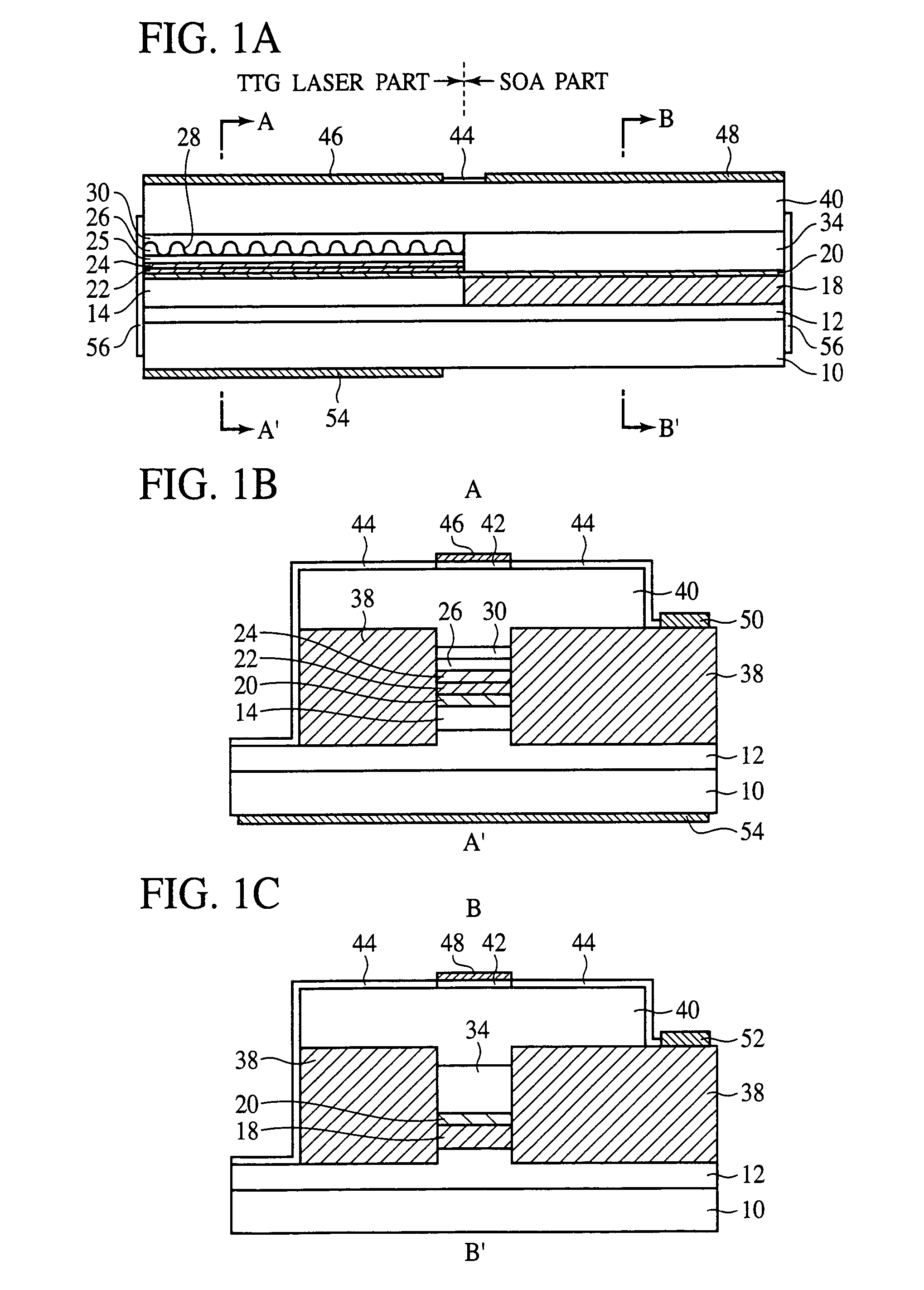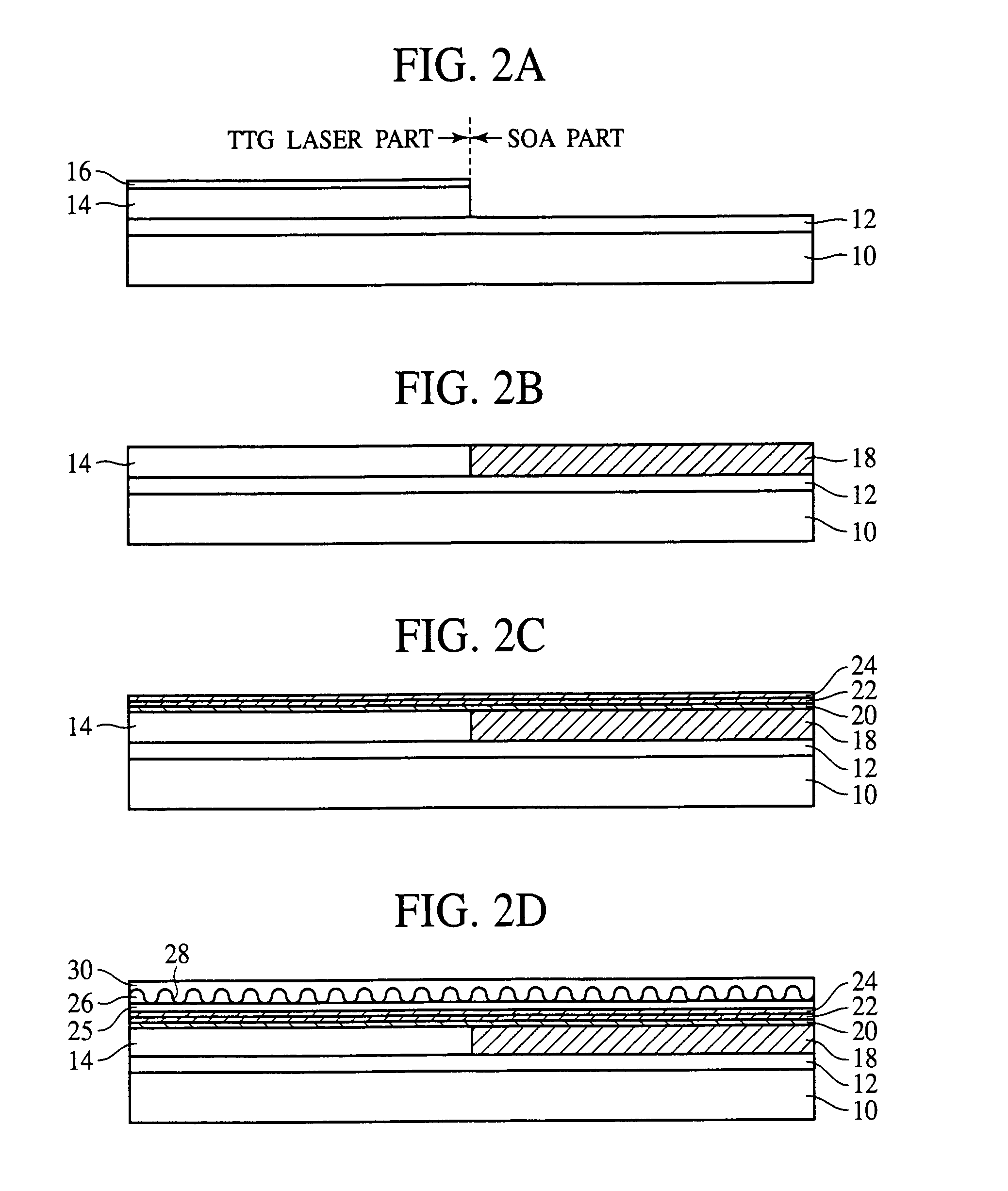Tunable wavelength laser
a wavelength laser and wavelength technology, applied in semiconductor lasers, semiconductor laser arrangements, active medium materials, etc., can solve the problems of complicated wavelength control, and large number of parts, and achieve wide wavelength variation range and high photooutput
- Summary
- Abstract
- Description
- Claims
- Application Information
AI Technical Summary
Benefits of technology
Problems solved by technology
Method used
Image
Examples
first embodiment
[0078][A First Embodiment]
[0079]The photosemiconductor device and the method for fabricating the photosemiconductor device according to a first embodiment of the present invention will be explained with reference to FIGS. 1A–1C, 2A–2D and 3A–3D.
[0080]FIGS. 1A–1C are diagrammatic sectional views of the photosemiconductor device according to the present embodiment, which show the structure thereof. FIGS. 2A–2D and 3A–3D are sectional views of the photosemiconductor device according to the present embodiment in the steps of the method for fabricating the photosemiconductor device, which show the method.
[0081]First, the structure of the photosemiconductor device according to the present embodiment will be explained with reference to FIGS. 1A–1C. FIG. 1A is a diagrammatic sectional of the mesa stripe along the extension thereof. FIG. 1B is a diagrammatic sectional view of the TTG laser part along the line A–A′ in FIG. 1A. FIG. 1C is a diagrammatic sectional view of the SOA part along the...
second embodiment
[0126][A Second Embodiment]
[0127]The photosemiconductor device and the method for fabricating the photosemiconductor device according to a second embodiment of the present invention will be explained with reference to FIGS. 4A–4C and 5A–5D. The same members of the photosemiconductor device according to the present embodiment as those of the photosemiconductor device and the method for fabricating the photosemiconductor device according to the first embodiment shown in FIGS. 1A–1C, 2A–2D and 3A–3D are represented by the same reference numbers not to repeat or to simplify their explanation.
[0128]FIGS. 4A–4C are diagrammatic sectional views of the photosemiconductor device according to the present embodiment, which show a structure thereof. FIGS. 5A–5D are sectional views of the photosemiconductor device according to the present embodiment in the steps of the method for fabricating the same, which show the method.
[0129]First, the structure of the photosemiconductor device according to ...
third embodiment
[0152][A Third Embodiment]
[0153]The photosemiconductor device and the method for fabricating the photosemiconductor device according to a third embodiment of the present invention will be explained with reference to FIG. 6. The same reference numbers of the present embodiment as those of the photosemiconductor device and the method for fabricating the photosemiconductor device according to the first and the second embodiments shown in FIGS. 1A–1C, 2A–2D, 3A–3D, 4A–4C and 5A–5D are represented by the same reference numbers not to repeat or to simplify their explanation.
[0154]FIG. 6 is a diagrammatic sectional view of the photosemiconductor device according to the present embodiment, which shows the structure thereof.
[0155]The basic structure of the photosemiconductor device according to the present embodiment is the same as that of the photosemiconductor device according to the first embodiment shown in FIGS. 1A–1C. The present embodiment is different from the photosemiconductor devi...
PUM
 Login to View More
Login to View More Abstract
Description
Claims
Application Information
 Login to View More
Login to View More - R&D
- Intellectual Property
- Life Sciences
- Materials
- Tech Scout
- Unparalleled Data Quality
- Higher Quality Content
- 60% Fewer Hallucinations
Browse by: Latest US Patents, China's latest patents, Technical Efficacy Thesaurus, Application Domain, Technology Topic, Popular Technical Reports.
© 2025 PatSnap. All rights reserved.Legal|Privacy policy|Modern Slavery Act Transparency Statement|Sitemap|About US| Contact US: help@patsnap.com



